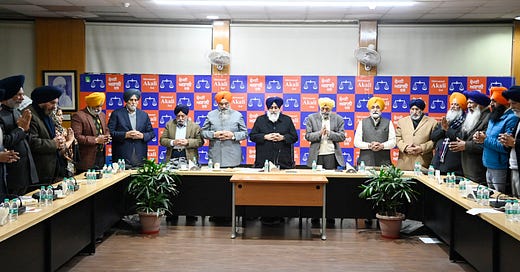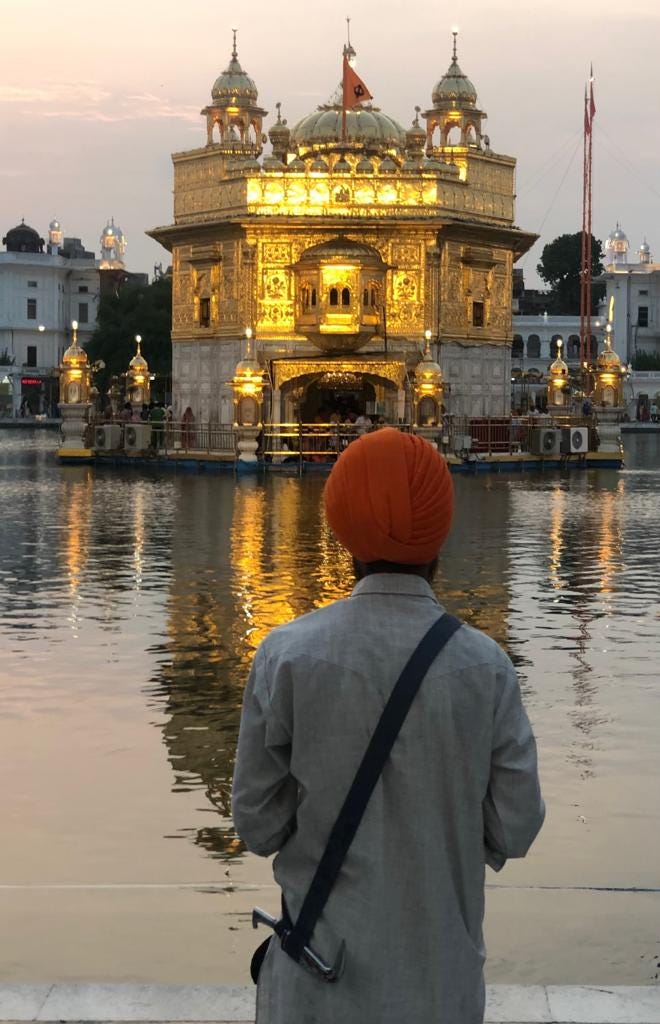Reviving Shiromani Akali Dal in Punjab: 5-Point Prescription
Differences between SAD President Sukhbir Badal and his brother-in-law and the Party's General Secretary, Bikram Singh Majithia are now out in open.
Background: An Alarming Wake-Up Call
The Shiromani Akali Dal's Core Committee Meeting, led by President Sukhbir Singh Badal, convened on January 3, 2024, in Chandigarh amid apparent internal rifts, notably the absence of General Secretary Bikram Singh Majithia. This meeting underscored a critical juncture for SAD. Out of power since 2017 and reduced to a mere three MLA seats in the Punjab Assembly, the party faces a grim political isolation. The upcoming 2024 Lok Sabha elections cast a long shadow with the SAD seemingly sidelined by major national alliances. Amidst this, the party's recent initiatives, including a lackluster program and muted response to significant national events, hint at a deeper crisis of direction and resonance with its base.
1. The Echo of Silence and Inaction
The revelations from the Core Committee's meeting are not very encouraging. The party's dependence on traditional vote bases and SGPC-driven programs, while notable for community service, fails to translate into a dynamic political vision or meaningful voter engagement. The lack of a strong socio-economic agenda and silence on critical national issues are indicative of a party struggling to adapt and remain relevant in an ever-evolving socio-political landscape. Adding to the concerns, the Shiromani Akali Dal's tweet, "The Shiromani Akali Dal’s core committee meeting today hailed the manner in which the entire party rank and file joined Sikhs in commemorating the Shaheedi Saptah," has drawn criticism. Sober scholars and devout Sikhs have pointed out that the use of the word "hail" is inappropriate and out of sync with the solemnity of the occasion, which marks the unparalleled martyrdom of the Sahibzadas. This mismatch between the party's language and the emotional and cultural resonance of such significant events highlights a deeper disconnect that needs to be addressed to restore credibility and sensitivity in its communication.
2. Punjab Bachao Yatra: A Tactical Misfire?
The 'Punjab Bachao Yatra', proposed to be launched from February 1, as a response to AAP's governance, has faced skepticism and is perceived as mere political posturing. In light of the sharp rebuke from CM Bhagwant Mann, highlighting past governance flaws attributed to SAD, it's clear the Yatra needs a strategic repositioning. Instead of serving as a reactionary measure, it should evolve into a platform that constructively addresses the pressing issues of Punjab's development, governance, and welfare. By pivoting towards a solutions-oriented dialogue that resonates with the daily lives of the Punjabi people and their aspirations, the Yatra can transcend its current image and become a credible and earnest initiative committed to the state's progress and prosperity. This reimagining is vital to rebuild trust and re-establish SAD as a responsive and responsible political force in the state.
3. Urban Disconnect and Communication Gaps
The committee's focus on the erosion of federal structures and the marginalization of regional parties is a topic of considerable intellectual and political importance. However, there is a concern that these discussions may not effectively reach or resonate with the broader voter base, especially those in rural areas who are critical to the party's support. The reliance on English-only communication on X (formerly Twitter) has further alienated its core Punjabi-speaking demographic, signaling a need for more inclusive and accessible language use, or at least a bilingual format. While the intention to hold seminars addressing Punjab's issues is a positive step, the party must ensure these efforts are tangible and relevant to all sections of the electorate, not just the urban educated and academic elite. The challenge lies in translating these complex political discussions into actionable and relatable content that engages and mobilizes the diverse population of Punjab, and reflects in meaningful dialogue and negotiation strategies, even with political adversaries like the BJP.
4. Addressing National Issues and the Hindu Vote
The Shiromani Akali Dal's reticence on pivotal national issues, notably the consecration of the Ram Janmbhoomi Mandir in Ayodhya, has been conspicuous. Considering the significant Hindu electorate in regions like Malwa, it's imperative for the SAD to develop and communicate a stance that acknowledges and respects these sentiments. Such engagement is crucial not only for broadening its voter base but also for maintaining its relevance in a diverse society. Strategically, acknowledging and celebrating shared cultural and religious heritage, such as the reverence for Lord Ram — widely mentioned in Sri Guru Granth Sahib both as a historical figure and a divine metaphor — aligns well with the party's core values and Punjab's inclusive ethos. This approach would not detract from its Sikh Panthic support but rather reinforce the syncretic nature of Punjabi culture and Sikhism's own broad-minded worldview. By embracing this nuanced understanding, SAD can affirm its commitment to all communities and ensure a more inclusive and representative political stance.
5. Internal Turmoil and Leadership Crisis
A pervasive sense of disarray and lack of direction was candidly admitted to us by a senior Akali Dal leader following the recent meeting. The party, described as both directionless and rudderless, seems to be grappling with significant internal challenges, including a failure to incorporate diverse internal perspectives and a lack of transparency regarding the committee's findings on the 2022 electoral losses. "No one is willing to listen to us," the leader lamented, expressing frustration at the disregard for constructive internal discourse. This sentiment underscores the urgency for comprehensive internal reform and a commitment to inclusive and effective leadership to steer the party back to relevance and effectiveness.
A Five-Point Strategic Revival Plan for Shiromani Akali Dal
1. Reaffirming Political Identity and Alliance Dynamics
Under the leadership of Sukhbir Badal, Shiromani Akali Dal must emerge from the shadows of its past alliance with the BJP-led NDA and re-establish its stance as an independent opposition entity, both in Punjab and at the national level. The party must adopt a balanced approach, responsibly critiquing the central government while acknowledging any beneficial policies for Punjab and the Sikh community. The absence at key national events like the Veer Bal Divas has been noted with disappointment by all concerned; going forward, a more engaged and visible presence is critical to send positive signals to the Sikh masses and affirm the party's commitment to Sikh values and national unity.
2. Championing Democratic Representation in SGPC
The stagnation of the SGPC's general body is a significant concern. Shiromani Akali Dal, led by Sukhbir Singh Badal, should champion the cause of democratic renewal by pushing for timely SGPC elections. This move would ensure the representation of young Sikhs who have come of age since the last election and demonstrate the party's commitment to democratic principles and the Sikh community's right to representation. Addressing this issue would also mitigate criticisms of using the SGPC for political leverage and reinforce the party's dedication to the Sikh community's welfare and self-governance.
3. Advocating for Sikh Rights and Identity
Article 25 of the Indian Constitution, a part of the Fundamental Rights, includes a special provision for Sikhs to carry the Kirpan. Shiromani Akali Dal should initiate a focused campaign to educate and encourage the youth, regardless of their Amrit status, to embrace this right. The campaign should be carefully designed to emphasize the Kirpan's role in Sikh identity, self-defense, and historical duty to protect all communities, echoing the legacy of Guru Teg Bahadur Ji. By doing so, SAD can reaffirm its commitment to Sikh rights while fostering communal harmony and understanding.
4. Bridging Factions and Strengthening Leadership
The visible rifts within the party, particularly between Sukhbir Badal and Bikram Singh Majithia, undermine the unity and effectiveness of Shiromani Akali Dal. To address this, a strategic restructuring might be necessary, potentially elevating Majithia to a more prominent leadership role given his active engagement and rapport with both rural and urban constituencies. This move could rejuvenate the party's operational dynamics, enhance its grassroots connection, and present a united front to the electorate.
5. Addressing Past Atrocities and Seeking Justice
The resurgence of the Jathedar Kaunke's report and the painful memories of 1986 highlight a crucial area where SAD must take a stand. The party needs to demand an exhaustive CBI investigation into these tragic events and the alleged extrajudicial killings, distinguishing itself from any past inactions. By actively pursuing justice and transparency in this matter, Shiromani Akali Dal can demonstrate its commitment to truth, accountability, and the healing of old wounds, reinforcing its role as a guardian of Sikh interests and justice.
Charting a Path Forward: Conclusion
As Shiromani Akali Dal stands at a crucial crossroads, the need for strategic introspection and reformative action is more pressing than ever. The proposed five-point plan serves as a comprehensive guide towards addressing the current challenges and harnessing potential opportunities for revival and growth. By tackling these issues head-on with dedication and foresight, the party can work towards rejuvenating its base, restoring lost credibility, and reinforcing its pivotal role in Punjab's political and social landscape. This plan is not just a set of recommendations but a call to action—a roadmap for the Shiromani Akali Dal to embark on a transformative journey towards renewed strength and continued significance. It's time for SAD to navigate through this pivotal juncture, revitalizing its connection with the people, upholding its proud heritage, and preparing for a future marked by greater unity, relevance, and impact. Mere rhetoric and symbolism shall not suffice.
.









Very good write up on SAD depicting its past presant and future. A big way introspection is needed